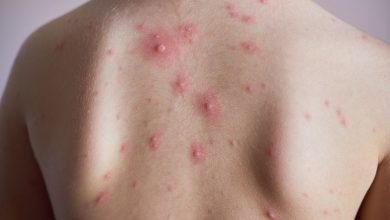Experts explain the causes and treatments of hidradenitis suppurativa, a persistent skin ailment.

The chronic skin illness named as hidradenitis suppurativa, or HS, is characterized by the formation of painful boils or lumps under the skin that can occasionally burst. Usually, it affects the groin and underarm regions. According to the Hidradenitis Suppurativa Foundation, between one and two percent of Americans have HS, with African American and mixed women being the most common victims.
Although the exact origin of HS is still unknown, the fact that the condition usually manifests around puberty raises the possibility that hormones may be involved. Because HS can be observed in family relatives of people affected, experts surmise that heredity most certainly plays a part in the disease. Studies also point to an overreactive immune response as the cause of HS.
What are the symptoms of Hidradenitis Suppurativa?
Usually, HS starts in the groin or armpits, where there is thick, coarse hair. People with HS may get outbreaks that resemble boils or zits. These outbreaks might eventually go away, but they might reappear later in the same location.
According to Tiffany Mayo, M.D., an associate professor in the UAB Department of Dermatology, “if these bumps keep coming back, especially in the same location, it might be Hidradenitis Suppurativa.” “I advise consulting a medical expert for assistance if you think you may have HS. Inform them of your experiences and inquire as to whether this might be Hidradenitis Suppurativa.
The appearance of sensitive, deep nodules that resemble cysts, boils, or zits is one of the earliest indicators of HS. Individuals with HS may experience some discomfort in that area prior to the nodule developing. The nodules may enlarge and unite as HS worsens, creating tunnels beneath the skin. This can cause the nodules to swell with pus and become uncomfortable, which is known as an abscess. Blood and pus may leak out of the abscesses if they burst. Tunnels and scarring may result from this recurring cycle of inflammation and repair. Some individuals see little, black pimples that resemble blackheads in certain regions of Hidradenitis Suppurativa flares.
People may believe that HS is contagious or the result of poor hygiene because it might occasionally resemble an infection, but that is untrue, according to Mayo. “Hidradenitis Suppurativa is a disease that causes inflammation. It’s not an infection. It is not communicable. Furthermore, it does not suggest inadequate personal cleanliness.
How is Hidradenitis Suppurativa diagnosed?
Dermatologists at UAB are qualified to distinguish between HS and other skin problems, even though HS can mimic other skin conditions in appearance. A dermatologist may inquire about Hidradenitis Suppurativa symptoms from a patient while performing an examination. In order to get more information that would help them make a diagnosis, they will speak with the patient and look at some of the lumps or nodules that have appeared.
How is Hidradenitis Suppurativa treated?
Dermatologists can create a treatment plan to manage some of the symptoms of Hidradenitis Suppurativa, such as minimizing flare-ups, healing wounds, lowering pain, and halting the condition’s progression, even though there is no known cure for Hidradenitis Suppurativa.
“Dermatologists can assist you in selecting the most appropriate course of treatment for your needs as they are well-versed in Hidradenitis Suppurativa,” Mayo stated.
Treatment regimens may involve skin care techniques, such as using specific products to lessen HS-related inflammation, or pharmaceuticals, such as biologics, retinoids, antibiotics, or hormone medicines that can decrease pus and inflammation. Dermatologists may resort to in-office operations including deroofing—removing the skin that covers an abscess so it may heal and seal off the tunnel or nodule—or corticosteroid injection, laser hair removal, laser surgery, or the removal of HS lesions. Dermatologists might give pain management or wound treatment priority. Dermatologists may also suggest therapy or support groups if HS has resulted in the patient experiencing anxiety or depression. This will help the patient feel less alone while they manage their illness. Clinical trials are still providing HS patients with new, better treatments.
UAB researchers develop a model for targeted intervention
Evidence exists to support the theory that HS is a complicated inflammatory skin condition involving interactions between the immune system and the epithelium. Researchers at UAB discovered a model for focused assistance for high school students last year. The chromatin landscape of the inflammatory gene implicated in Huntington’s disease (HS) may be blocked by combining biological therapy with specific drugs, according to a study published in the Proceedings of the National Academy of Sciences.
In this study, UAB researchers examined HS epithelial cells to show that basal cells, which are found at the base of the epidermis, the skin’s outermost layer, have the ability to regulate their lineage and produce more keratinocytes, which are primarily responsible for the skin’s protection and repair.
According to this study, alterations in the skin’s microbiome, dysregulated immunological response, and keratinocyte dysfunction are likely the causes of HS start and development. Mohammad Athar, Ph.D., is a professor and vice chair of Research in the UAB Department of Dermatology. However, Athar and his team—which included research faculty members at the UAB Department of Dermatology Lin Jin, Ph.D., and Chander Raman, Ph.D.—investigated the HS skin cells in order to learn more about the underlying cause of this condition. They discovered that basal progenitor cells, which act as skin repair cells, dysregulate their lineage restriction and increase pathogenic keratinocyte clones, which causes an increased growth of skin cells and HS inflammation.
The study team found two groups of keratinocytes that enhance immunological responses in individuals with HS and described the altered transcriptional profiles in HS basal stem/progenitor cells. S100A7/8/9 and KRT6, which cause IL1 and IL10 and regulate the immunological and inflammatory responses to an infection, are genes that identify these populations. These signals attract particular immune cell populations and advance the disease together with cytokines and chemokines unique to hemoglobin S.
A database revealing different patterns of chromatin accessibility in skin with HS versus skin in good health was offered by the researchers in the study. The ease with which other molecules in the body can interact with a person’s DNA is referred to as chromatin accessibility. Numerous active enhancers were discovered by the researchers, and these significantly and specifically stimulate the production of inflammatory genes in HS. Through the combination of innovative pharmacological drugs and biological therapies, researchers were able to uncover a pattern for targeted intervention in HS patients by blocking the chromatin landscape of genes that cause inflammation.
According to Athar, HS is a crippling skin condition that lowers quality of life in young patients, especially in Black women. Our lab’s research aims to comprehend the root causes of gender bias and racial diversity. In the end, Dr. Lin Jin hopes to find a personalized treatment for this illness by creating innovative epigenetic techniques. The primary cause of HS will be identified as distinct cell populations with distinct gene signatures, which will serve as the basis for the diagnosis of the condition in each patient. We believe that our extremely creative approach to finding a highly effective treatment for these patients will soon be successful.


